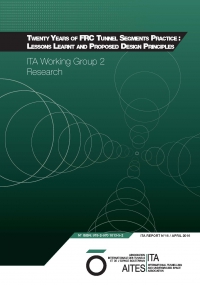The construction of underground infrastructures for transport purposes (roads, railways, and metro),
for mountain, sea straits or rivers crossing, for water transportation (clean or sewage water), and for
utilities, including multi-purpose tunnels has a key role in the development of modern society. In this
context, the use of mechanised tunnelling faces continuously increasing challenges in terms of diameter,
depth, machine power, adaptability to different geological context. Consequently, the conception of
the lining - usually made of precast segments - has to evolve accordingly in terms of mechanised
behaviour, bearing capacity, crack control and water-tightness.
In the last two decades, the use of Fibre Reinforced Concrete (FRC) progressed and was adopted
in several tunnel projects. Among the benefits related to the inclusion of fibre reinforcement in the
cementitious composites, the most important is the noticeable increase of the post-cracking tensile
residual properties. In addition, the fibre reinforcement facilitates production process of the lining
segments. The enhancement of the general structural behaviour together with the improvement of
the industrialized production of precast tunnel segments are probably the two main key-factors of the
continuously growth in using FRC in precast tunnel linings.
The aim of this report is to provide advances in the design of FRC tunnel lining in accordance with the
objectives of the International Tunnelling Association (ITA) prescribed in Section II of the Statutes of
the ITA (ITA, 1976). Standards and recommendations related to the design of general FRC elements
are already available, but they do not provide details on specific requirements and loading conditions
applicable in the case of tunnel lining segments. The scope of the report is hence to take advantage of
twenty years of FRC practice in precast tunnel lining - including research and feedback from real cases
– to provide additional design principles which complete the existing standards and recommendations
for the specific case of tunnel lining.
This document was conceptually agreed during the meeting of ITA Working Group 2 (WG2) in Budapest,
2009. The first early draft document was presented in Vancouver, 2010. After several discussions and
meetings within WG2 the current version was completed, it was reviewed by the WG2 members, and
it went through the formal approval process of ITA.


